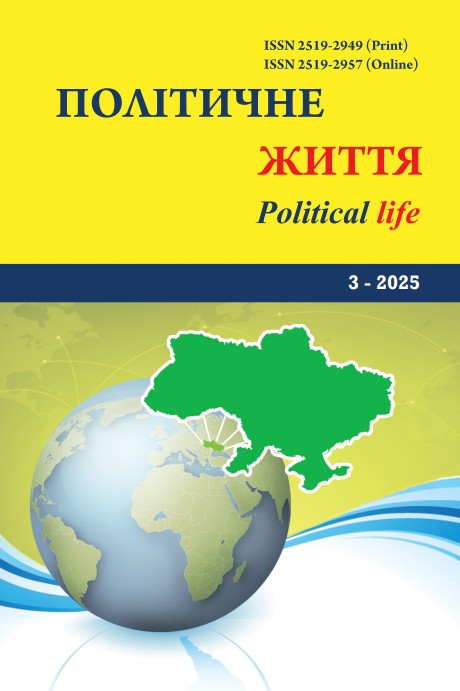Symbolic support of Policy: systematization of the experience of the European Union
DOI:
https://doi.org/10.31558/2519-2949.2025.3.8Keywords:
symbolic reality, political symbols, experience of the European Union, verbal and non-verbal symbols, Lisbon Treaty, European identityAbstract
The proposed article systematizes the experience of the European Union related to strategic and procedural symbolic support of political development. The official and unofficial, verbal and non-verbal symbols of the European Union are considered: Europe Day, the slogan of the European Union, the European flag, the European Anthem, the passport of an EU citizen, the euro, the myth of the abduction of Europe, the Lisbon Treaty, the Manifesto for the Restructuring of Europe. The influence of political symbols on changes in standardization and worldview of representatives of EU member states is analyzed. The protocol practice of using European symbols is highlighted. The role of the symbolic component in the process of forming a European identity is revealed. It is found that the symbols of the EU are implemented in practice in various contexts - political, social, cultural, sacred, image, procedural, lexical-semantic, etc. It is proven that symbolic reality is an important object of political science research, since it is able to figuratively and symbolically reflect the aspirations of the electorate, the political strategy of the state, universal human values, and form the moral and spiritual basis of a certain community. It is argued that for Ukraine, in the conditions of its dynamic movement towards the European Union, this experience becomes decisive, since the use of symbolic resources in domestic and foreign policy is currently considered an important sign of development, communicative capacity, openness and democratic direction of the state. An important direction for further research into symbolic reality is the systematization of European experience in ensuring symbolic policy. The use of European symbols is part of Europe's strategic progress, which means strengthening the idea and value of European unity in the minds of the peoples inhabiting the continent.
References
Forest F. Symbolic dimensions of EU legitimization. Media, culture and society. № 31 (2), march, 2009. P 9–14.
Ковалів М. В., Тимчишин Т. М., Ніканорова О. В. Основи права Європейського Союзу: навчальний посібник. Львів: Львівський державний університет внутрішніх справ, 2020. 212 с.
Пелагеша Н. Україна у смислових війнах постмодерну: трансформація української національної ідентичності в умовах глобалізації: монографія. Київ: НІСД, 2008. 288 с.
Волинець К. В. Лісабонський договір та його основний зміст. Лісабонський договір – 10 років після набуття чинності. Що змінилося у функціонуванні ЄС?: Науково-практична конференція: тези доп. Миколаїв, 02 грудня 2019 р. / ЧНУ ім. Петра Могили. Миколаїв: ЧНУ ім. Петра Могили, 2019. С. 39–40.
Manifesto for re-building Europe / Daniel Cohn-Bendit, Ulrich Beck and others. Mode of access. URL: http://habermas-rawls.blogspot.com/2012/05/manifesto-for-re-buildingeurope.html.
Gottdiener M. Postmodern Semiotics. Material Culture and the Forms of Postmodern Life. Oxford, 1995. 272 р.
Лебідь Н. М. Конструювання образу Європи з використанням семіотизації медіамови. Вчені записки ТНУ імені В. І. Вернадського. Серія: Філологія. Журналістика. 2021. Том 32 (71). № 6. Ч. 3. С. 237–241.
Metaphor and metonymy at the crossroads: A cognitive perspective / Ed. by Antonio Barcelona. Berlin, Nev York, 2000. 356 p.
Тихомирова Є. Б. Вербальне та візуальне позиціонування зовнішніх проектів Європейського Союзу. Науковий вісник Волинського національного університету імені Лесі Українки. 2011. № 21. С. 83–89.
Cultural identity and archaeology: The construction of European communities / Ed. by C.S. Gamble, P Graves-Brown, Sian Jones. L.: Routledge, 1996. 304 p.
Горбатенко В. П. Європейський вибір України в умовах російсько-української війни. Правова держава: Щорічник наукових праць Інституту держави і права імені В. М. Корецького НАН України. Випуск 36. Київ, 2025. С. 319–331.

